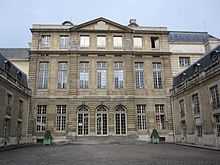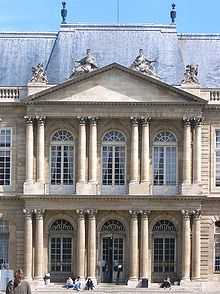Pierre-Alexis Delamair


Pierre-Alexis Delamair (French pronunciation: [pjɛːʁ aleksi dəlamɛːʁ]) (Châtenay-Malabry 1675/6 — Agde 25 July 1745) was a French architect, theorist and city planner, whose ambitious plan for a rational restructuring of the center of Paris, 1737, never came to fruition, as it would have required the demolition of the existing city to be replaced with an ideal city.
Delamair was the son of Antoine Delamaire, and received his training in the Bâtiments du Roi, directed by Robert de Cotte.[1] His three works on architecture remained in manuscript. In one, Delamair proposed in 1725 enlarging and connecting as one, the three islands in the Seine, the Île de la Cité, the Île Saint-Louis, and the Île Louvier, to make a single Île de Paris that would make a more suitable site for the Hôtel de Ville. The idea was taken up by Pierre-Louis Moreau-Desproux in 1769[2] and expanded towards the end of the 18th century by Pierre Patte and by Charles De Wailly.
Delamair completed three hôtels particuliers, the Hôtel de Soubise at Paris (1704–1709), for François de Rohan, prince de Soubise, and the adjoining Hôtel de Rohan (1705–1708), built for Soubise's son, Armand-Gaston, bishop of Strasbourg,[3][4] and revisions to the former Palais Rohan at Strasbourg (1705–1708, demolished within Delamair's lifetime for the present structure). His replacement at the Rohan houses by Germain Boffrand, at the moment of his precocious triumph, left him an embittered man.[5]
Notes
- ↑ Michel Gallet, Les Architectes parisiens du XVIIIe siècle, Paris: Editions Mengès, 1995.
- ↑ "Moreau a pu s'appuyer sur le projet de Delamair, conservé à l'Arsenal. L'original du sien a brûlé à l'Hôtel de Ville en 1871, mais nous est connu par un album aquarellé (Bibl. nat. Estampes, Ve 36)". (Michel Gallet, Les Architectes parisiens du XVIIIe siècle, p. 372).
- ↑ Gallet 1995
- ↑ Andrew Ayers, The Architecture of Paris: an architectural guide Stuttgart: Edition Axel Menges, 2004 ISBN 3-930698-96-X; both now house the Archives nationales
- ↑ Fiske Kimball, The Creation of the Rococo, 1943; p. 93; Kimball refers to Delamair's "secondary rôle".